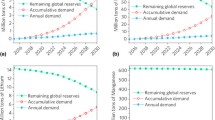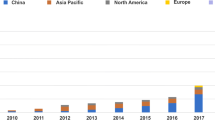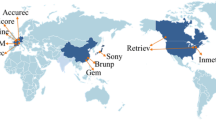Abstract
Lithium-ion batteries (LiBs) are increasingly in demand for energy storage and use in electric vehicles. Recycling of these end-of-life (EOL) batteries is considered one of the most effective ways for recovering elements such as lithium, manganese, cobalt, and nickel and circulating them back to the battery materials’ supply chain. However, few articles have been published which discuss the recycling chain, starting from LiBs to the production of battery grade (BG) nickel/cobalt sulfates (which are used to produce pCAM) with CAPEX, OPEX, and timeline estimates. This article summarizes the pretreatment process of LiBs to Black Mass and compares subsequent hydrometallurgy processes to convert Black Mass to BG sulfates, along with high-level summaries of the CAPEX, OPEX, and timelines. Besides, the critical path of project implementation is also presented.
Access this chapter
Tax calculation will be finalised at checkout
Purchases are for personal use only
Similar content being viewed by others
References
Dai Q, Spangenberger J (2019) EverBatt: a closed-loop battery recycling cost and environmental impacts model. Argonne National Laboratory
Fortum, Fortum’s battery material recycling facility gets ready to begin operations in 2023 – Staff members moving onsite in December (2023)
Fozia Anjum MS (2012) Biohydrometallurgy techniques of low grade ores: a review on black shale. Hydrometallurgy 117–118:1–12
He L-P, Sun S-Y, Song X-F, Yu J-G (2017) Recovery of lithium, nickel, cobalt, and manganese from spent lithium-ion batteries using l-tartaric acid as a Leachant. ACS Sustain Chem Eng 5:714–721
Jia Li GW (2016) Environmentally-friendly oxygen-free roasting/wet magnetic separation technology for in situ recycling cobalt, lithium carbonate and graphite from spent LiCoO2/graphite lithium batteries. J Hazard Mater 302:97–104
Jingu Kang GS (2010) Recovery of cobalt sulfate from spent lithium ion batteries by reductive leaching and solvent extraction with Cyanex 272. Hydrometallurgy 100:168–171
Jinqiu X, Thomas HR (2008) A review of processes and technologies for the recycling of lithium-ion secondary batteries. J Power Sources 177:512–527
Kaya M (2023) State-of-the-art lithium-ion battery recycling technologies. Circ Econ 1(2)
Kim S, Bang J (2021) A comprehensive review on the pretreatment process in lithium-ion battery recycling. J Clean Prod 294(524):126329
Kumar Jai NR (2022) Recent progress in sustainable recycling of LiFePO4-type lithium-ion batteries: strategies for highly selective lithium recovery. Chem Eng J 431:133993
Laura Lander T, Cleaver T (2021) Financial viability of electric vehicle lithium-ion battery recycling. iScience 24:102787
Lee CK, Rhee K-I (2003) Reductive leaching of cathodic active materials from lithium ion battery wastes. Hydrometallurgy 68:5–10
Li-Cycle (2022) Retrieved from https://investors.li-cycle.com/news/news-details/2022/Li-Cycle-Holdings-Corp.-Reports-Financial-Results-for-Fourth-Quarter-and-Full-Year-2021-Significant-Progress-in-Advancing-Spoke-and-Hub-Network-Strategy/default.aspx
Lithion (2023) Retrieved from https://www.lithionrecycling.com/lithium-ion-battery-recycling/
Mackenzie W (2021) Retrieved from https://www.woodmac.com/press-releases/700-million-electric-vehicles-will-be-on-the-roads-by-2050/
Nayaka GP, Manjanna J (2015) Recovery of valuable metal ions from the spent lithium-ion battery using aqueous mixture of mild organic acids as alternative to mineral acids. Hydrometallurgy 151:73–76
Northvolt, Northvolt launches recycling program targeting 50 percent recycled material in new cells (2019)
Pinna EG, Ruiz MC (2017) Cathodes of spent Li-ion batteries: dissolution with phosphoric acid and recovery of lithium and cobalt from leach liquors. Hydrometallurgy 167:66–71
Rebecca E, Ciez JF (2019) Examining different recycling processes for lithium-ion batteries. Nat Sustain 2:148–156
Rong-Chi W, Lin Y-C, Wu S-H (2009) A novel recovery process of metal values from the cathode active materials of the lithium-ion secondary batteries, vol 99. Hydrometallurgy, pp 194–201
Silveira AVM, Santana MP (2017) Recovery of valuable materials from spent lithium ion batteries using electrostatic separation. Int J Miner Process 169:91–98
Stone M (2021) As electric vehicles take off, we’ll need to recycle their batteries. Retrieved from https://www.nationalgeographic.com/environment/article/electric-vehicles-take-off-recycling-ev-batteries
Torabian MM, Jafari M (2022) Discharge of lithium-ion batteries in salt solutions for safer storage, transport, and resource recovery. Waste Manag Res 40:402–409
Wojciech Mrozik MA (2021) Environmental impacts, pollution sources and pathways of spent lithium-ion batteries. Energy Environ Sci 14:6099–6121
Zachary JB, Bird RE (2022) Lithium-ion battery recycling─overview of techniques and trends. ACS Energy Lett 7:712–719
Zhong X, Liu W (2020) Pretreatment for the recovery of spent lithium ion batteries; theoretical and practical aspects. J Clean Prod 263:121439
Acknowledgments
Thanks for the support from Hatch Hydromet Group and all those who contributed to the publication of this article.
Author information
Authors and Affiliations
Corresponding author
Editor information
Editors and Affiliations
Rights and permissions
Copyright information
© 2023 The Author(s), under exclusive license to Springer Nature Switzerland AG
About this paper
Cite this paper
Han, Y., Bedrossian, S., Fraser, R., Bellino, M., Bibienne, T. (2023). Lithium-Ion Batteries Recycling Trends and Pathways: A Comparison. In: Proceedings of the 62nd Conference of Metallurgists, COM 2023. COM 2023. Springer, Cham. https://doi.org/10.1007/978-3-031-38141-6_22
Download citation
DOI: https://doi.org/10.1007/978-3-031-38141-6_22
Published:
Publisher Name: Springer, Cham
Print ISBN: 978-3-031-38140-9
Online ISBN: 978-3-031-38141-6
eBook Packages: Chemistry and Materials ScienceChemistry and Material Science (R0)




